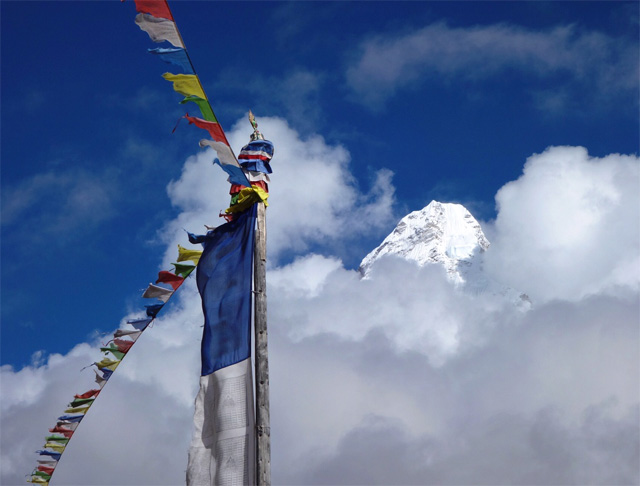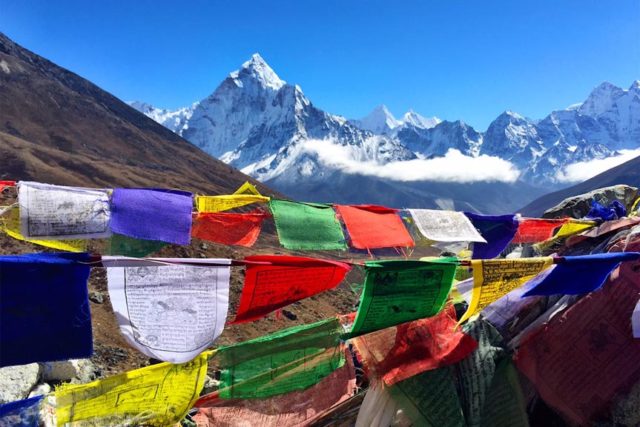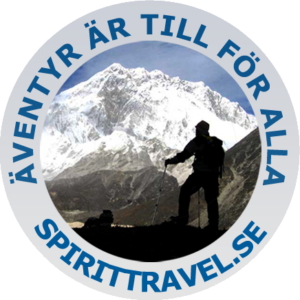I find myself in bed at the cardiac intensive care at Norvic International Hospital in Kathmandu. This was not how I had imagined my climbing trip to Nepal would end. It’s totally surreal, I am located in a room with 12 beds and an equal number of patients. In front of me lies a 17-year-old girl who has been run over by a bus. She will die in front of my eyes before I get to leave the hospital.
How did I end up here?
Just over two weeks earlier I began my journey to Nepal, Sagarmatha National Park. The plan was to climb Kala Pathar Peak, Lobuche and Island Peak. (see posts about this here) It was with great pleasure and much euphoria that I landed in Kathmandu, inhaled the familiar scents, sounds and moods in Nepal’s vibrant capital. It was almost exactly as I remembered it, and my soul was filled with harmony and joy.
Once at the hotel, I soon met up with the rest of the group I was to hike/climb with, and we spent a little over 24 hours in Kathmandu doing sightseeing and socializing. Everything felt and was perfect!
Everything went according to plan and we lived through the somewhat hysterical and adrenaline fueled landing at the Lukla airport – a challenge even for the strongest nerves.
So I was here again – in the mountains – where I feel so at home, feel so good. And it’s always a satisfying feeling to lace my boots, take my backpack and start hiking. It’s almost a bit dissipative to start what we all have come there to do, to wander at high altitude, to experience the amazing mountains and eventually get to summit, in this case, three of them.
I write about the hike – which was fantastic – in the post ‘Trekking at high altitude’. This very post you are reading now, is instead about how the trip was going to end up in a hospital instead of at the top of Island Peak and Lubuche.
After two weeks in the mountains, I am at the summit of Kala Pathar. I have been here before. I have looked at Mount Everest, Nuptse, Lhotse, Ama Dablam, and all the other mountains that are so beautiful that it almost hurts. It’s an overwhelming feeling to climb very, very high up and just absorb life. I will most certainly be here again – it’s too beautiful, too good to resist.
Up to this moment, and actually in this very moment itself, I was feeling strong. Actually better than what I usually feel so far into the trek, or at this altitude. I felt very, very strong.
Kala Pathar is almost 5,600 meters above sea level. Before the day is over, we’ll have wandered down to Dingboche at 4,300 to rest for a bit and prepare for the climb of Island Peak. For those of you who are not familiar with how height affects you, a descent of almost 1,300 meters i huge. This will usually result in that you feel much better, that your breathing will get better, that a little appetite comes back and that your sleep improves. And this was the case for me too. For the first time in almost a week I fell asleep immediately when i lied down. I really needed that after three nights with almost no sleep at all.

At breakfast, the symptoms had not passed at all, everything I did, including sitting still – caused hyperventilation, or very heavy breathing. It was really, really hard that it did not pass. After about an hour, I moved my breathless body down to the local nursery to listen to my respiration and to the lungs, in order to find out if we, by joining forces, were able to figure out what this was about. Annika, one of the participants, as well as a doctor, found that my left lung sounded numb and did not ventilated as it should. This was, with the highest probability, due to an incipient bronchitis (commonly found in high altitude) or maybe pneumonia. So far, so good. But…
…the symptoms could also be caused by a possible blood clot in the lung. The fact is that the risk of precisely blood clots, also increases significantly at high altitude (see this page on altitude’s effect on body and health). In addition to this, my dad had a blood clot at my age, which also entails a further increased risk as this is/can be hereditary. Ok…? How do I handle this information?
To lose altitude, or go down, is the recommendation number 1 in all cases where you get problems with health at high altitude. Given my state – that breathing was not at all better – I pretty quickly took the decision to start descend. Hence, I abort my climb upwards to instead start by walking down to Pangboche at about 3,800 meters.
On my way to Pangboche, which takes about two hours or so, I have plenty of time to, of course, reflect a lot on how I should handle the information that I have just received. I’m not particularly afraid that there really is a blood clot, but it stands to reason that the notion is there. What if this is it? What happens if it comes off?
Once in Pangboche my breathing is somewhat better, but far, far from good. And had it not been for a Norwegian guy I talked to a bit in the tea house where I had lunch, I probably would have slept in Pangboche one more night, to find how I would feel the next day. But what he told me was simply – ‘you can’t take any chances’. I had obviously come to this insight myself earlier – but sometimes you need a kick in the butt to make it happen. With his words ringing in my ears I took the decision to ensure that I’d get to take the necessary x-rays in Kathmandu. If this was a blood clot, there was no excuse for not making it to a hospital.
Said and done, after some conversation with the insurance company, I soon sat in the helicopter and was on my way to Kathmandu. At this point my climbing adventure this time was definitely ended. But I have chosen to live here and now. Things happen for a reason. And the mourning over the missed peaks was at this point had already passed. Now I was most anxious to get my lungs x-rayed to rule out any clot.
The helicopter trip itself, was also, an experience. And not just for the fantastic experience of flying at low altitude over the most beautiful scenery, sometimes in gorgeous sunshine, sometimes in the pouring rain. It was also an experience because, due to the lack of fuel supply, we did not have enough fuel to get all the way to Kathmandu. We were thus forced to refill in Lukla, and via a vast number of plastic containers we slowly refilled the machine.
In Lukla our pilot was offered hot food, which he accepted and ate inside the helicopter. But he doesn’t finish the meal and chooses to bring the plate with him, when we lift again. Once up at cruising altitude, he picks up the plate from the floor and ends his lunch while he safely (?) flies towards the capital. Now, I don’t know much about Nepalese flight safety regulations, but to divide your attention between mountain peaks, gusts of wind, cloud, rain, and any other cruising helicopter or airplane with a hot pot of noodle soup, well, I don’t know if that’s standard.
In Kathmandu, I am soon taken to hospital. In addition to the usual controls of oxygenation, heart rate, blood pressure, normal blood tests and an electrocardiogram, I would also become acquainted with the phenomenon of ABG. This is a blood gas test and I was informed, moreover, that it would be, I quote ‘very, very, very painful’. Well, that’s nice. In fact the first actual sampling was now not so very, very painful as they had promised. But … it turns out that this was not the last ABG test that I would endure and before my hospital stay was over, they would have proven that it was just very, very, VERY painful.
After one hour’s sampling, I am informed that I have to be admitted for observation for 24 hours. This was just not something I longed for, now that we, after x-rays of the lungs, had assured that there was no blood clot. Instead, I looked forward to check in at the hotel, eat a good dinner, and go to bed in a comfortable hotel bed and sleep a long, long, long time. I really needed that rest after all this. But health is more important than anything else. If the doctors had reason to want to observe (and, would it prove, to make lots of new tests) I actually had no reason to question them.
Wearing a far too small hospital gown, I was rolled in to the cardiac intensive care in a wheelchair. The ICI was where they had a bed to spare for the night. This part of my experience, I can still do not actually relate to, as if it never really happened to me.
When I rolled in and ‘toke place’ in bed, I realized that this is really an intensive care unit and the 12 patients, who lie there, are in considerably worse conditions than me. Life-threatening would be the terms I’d put on pretty much on everyone’s status. And in an instant my survival mechanism kicks in and in order to be able to live through this day I just turn off most or all of my perception. Else it would be too much to handle. So in a totally unreal, strange, previously never experienced, this is just what I do. I see people, coughing, whimpering, I see them lying still – I see them get intensive care, cardiac help, recently operated on, dying, in great pain. I see the 17-year-old girl die. I see her mother and father, her relatives break down right in front of me.
But as I am outside of myself, I don’t perceive it, it’s not real. It’s sort of like Kafka’s The Trial – nothing that you can relate to, because I cannot understand. The mind would blow if I tried to grasp it. So here I am, two weeks later, and it still feels like something I haven’t been through at all. But I have. I know it. I still have the bruises in my wrists to prove it.
The very weekend when I am admitted there is the Dashain – a grand festival which is celebrated in Nepal each fall. The physician was supposed to discharge me the morning after, but of course, he also celebrates Dashain and doesn’t seem to be really eager to come to the hospital to discharge me. But in order for me to leave the hospital – he has to. I neither can nor may I leave the hospital before he does. If nothing else the guards, who takes their mission highly serious, will make sure I stay in bed, among the dying in the ICU.
That’s when my ‘quest’ to get out from the hospital begins. I have to leave. Seven hours later I will have met the doctor, I will have agreed on doing a lot of re-sampling, I will have waited a little and agreed on the fact that I may leave the hospital if I promise to come back the day after. I will have waited a little more, rolled out from the ICU, I will have stood in line to pay my bill, and finally I will have put my butt on the motorcycle for the trip to the Hotel Nirvana Garden – both literally and figuratively a very fitting name at this moment.
The epilogue, however, is not written yet. I still don’t know what happened or why my lung behaved as it did. I will try to find out here at home. Maybe this experience will catch up with me one day, maybe not.
What I do know is that there wasn’t a blood clot.
What I do know is that I’m at home, I’ve been hugged and I have kissed Alvin so many times that he’s got a severe dad-allergy.
What I do know is that I am alive – very much so.
What I do know is that the mountains are still there.













